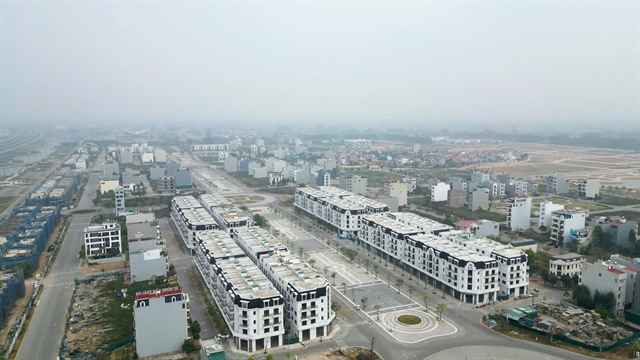 Society
Society


|
| Staff look at electronic medical records at the Department of Intensive Care and Anti-Poison in the Lạng Sơn Province General Hospital.— VNA/VNS Photo Anh Tuấn |
HÀ NỘI — The nationwide rollout of electronic medical records (EMRs) in hospitals is still facing obstacles related to infrastructure, data management and costs as well as a shortage of IT personnel, causing progress to lag behind original targets.
Under the plan, the original deadline for all hospitals across the country to complete EMR deployment was September 30.
However, figures from the Department of Science, Technology and Training under the Ministry of Health show that as of last Friday, only around 760 out of 1,650 hospitals (both public and private) had implemented EMRs at varying levels.
From October 1 until mid-2026, more than 130 additional medical facilities are expected to officially adopt the system, reflecting the accelerated efforts by localities to keep pace with the healthcare sector’s digital transformation roadmap.
Health Minister Đào Hồng Lan acknowledged that the nationwide rollout has missed its September 30 target.
She said that a number of hospitals that were transferred from the Ministry of Labour, Invalids and Social Affairs to the Ministry of Health are still struggling with their information software systems.
Administrative restructuring and slow procurement processes have also delayed implementation, making it impossible to complete the nationwide rollout on schedule, she said.
Meanwhile, Deputy Health Minister Đỗ Xuân Tuyên noted that medical record templates remain inconsistent in terms of professional categories.
Regulations and guidelines for IT procurement and digital transformation also remain difficult to apply in practice.
Compounding the problem, there is still no official pricing mechanism for medical services that factors in IT costs, including for picture archiving and communication system operations, without film printing.
“This has placed pressure on resources,” Tuyên said.
Many hospitals are also struggling with outdated IT infrastructure, obsolete diagnostic equipment that cannot generate digital data, underperforming software, weak cybersecurity and significant disparities in digital readiness between higher-level hospitals and local clinics.
“This has limited the effective operation of EMRs,” the deputy health minister noted.
A shortage of dedicated IT personnel is another challenge.
Both healthcare staff and patients are still unfamiliar with digital platforms, leading to difficulties in operating EMRs effectively.
Budget constraints are also a major barrier, as there is currently no dedicated budget line for IT or EMRs.
Most hospitals rely on their development investment funds, which diverts resources from other essential activities.
In remote, mountainous and island areas with limited revenues, hospitals lack the funds altogether and need support to adopt EMRs.
Đông Anh General Hospital Director Chu Đình Năng said that initial costs for EMR implementation were estimated at VNĐ4-6 billion (US$151,400-227,000) but have now reached approximately VNĐ10 billion ($378,600), a heavy burden for self-financed hospitals.
The same difficulties have been reported in other major hospitals in Hà Nội.
One representative from a grade-one general hospital said outdated IT infrastructure and high security costs have made effective EMR operation a formidable challenge.
With all patient data digitised, the risks of cyberattacks or leaks are ever-present.
In one instance, it took nearly a month for a hospital to recover from a system failure and restore a secure data environment.
During that period, operations were repeatedly disrupted.
Without direct data entry, medical staff were forced back to paper records and had to work night shifts for more than 10 days to input the backlog of patient information.
Such challenges highlight the need for comprehensive investment, high-level security and long-term planning if the digital transformation of healthcare is to succeed, he said.

|
| A doctor reads an electronic medical record at Việt Tiệp Friendship Hospital.—VNA/VNS Photo |
Associate Professor Trần Quý Tường, chairman of the Việt Nam Association of Medical Informatics, said that although all medical facilities have adopted IT to build management systems and connect data with the Social Insurance agency, EMR implementation remains sluggish.
He pointed to three main causes. Hospital leaders are still hesitant to embrace major changes in management practices; enforcement mechanisms are not strong enough to ensure compliance with the roadmap; and there is no clear financial guidance for funding, maintaining and operating EMR systems, which represent a considerable cost for many hospitals.
To accelerate progress, the ministry recently issued an urgent directive requiring hospitals to act promptly and take responsibility for their implementation timelines.
Success stories
Despite the difficulties, several provinces and cities have emerged as frontrunners in EMR adoption.
Following a determined six-month campaign, the central province of Nghệ An has become one of the first areas nationwide to implement EMRs across all local medical facilities.
By late 2024, only 12 of its 53 hospitals had adopted EMRs - but as of September 20, all 53 hospitals and medical centres with inpatient beds have completed implementation.
This figure includes 42 public hospitals, 11 health centres and 16 private and international hospitals, as well as specialised institutions under ministries and sectors such as Military Hospital 4, the Provincial Police Hospital, Vinh Medical University Hospital and Quỳnh Lập National Leprosy and Dermatology Hospital.
Another success story is in HCM City, where 153 of the city’s 164 hospitals had deployed EMRs by last Friday, a rate of over 93 per cent.
All 60 of the city's public hospitals have gone digital, as have 13 out of 14 ministry-affiliated hospitals and 80 of 90 private hospitals.
The city’s results are attributed to a series of initiatives, notably the pilot of a shared EMR platform to support public hospitals with limited resources.
The solution allows data synchronisation, links hospitals with the city’s healthcare database, enhances management and analysis capacity, and provides a comprehensive picture of community health to aid policy planning and forecasting.
Other provinces have also made rapid progress.
In the central coastal province of Quảng Ngãi, many facilities have completed EMR deployment, with Bình Sơn Medical Centre standing out for its seamless software integration, digital signatures and strict data security.
Meanwhile, in the mountainous northern province of Lạng Sơn, 14 medical facilities launched EMRs simultaneously 12 days ahead of schedule, marking an important step towards modernising hospital management, reducing administrative procedures and improving patient services. — VNS




